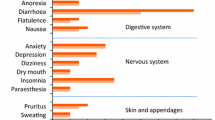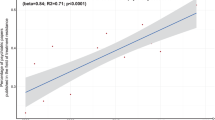Abstract
In an excellent methodological approach, the European acamprosate study project showed that acamprosate increases sobriety times. In one randomized prospective study (n=260) comparing acamprosate and placebo, with a 1-year treatment phase and 1-year follow-up phase, the authors found that acamprosate is effective only in Lesch type I and type II patients. To investigate the possible influence of diagnostic subgrouping, we applied the Lesch typology in a co-work with the main researchers of the UK study. The UK results concerning acamprosate's effects in the types do not mirror the Vienna results, but the numbers of type I and type II patients, retrospectively found as included in the UK centers, were too small for any conclusions. The distribution of the types points to the fact that too many type III and IV patients had been included to give acamprosate the chance to be effective. Following our typology and also these studies, we developed special treatment approaches. For relapse prevention studies, the cumulative abstinence duration together with the Lesch typology seems to be promising.
Similar content being viewed by others
References
Aubin JH. Experience with acamprosate in clinical practice (abstract). First Campral Symp, ESBRA, Stuttgart, September 1995.
Besson J, Aeby F, Kasas A, Lehert Ph, Potgieter A. Combined efficacy of acamprosate and fisulfiram in the treatment of alcoholism: A controlled study. Alcohol Clin Exp Res 22:573–579;1998.
Boismare F, Daoust M, Moore N, Saligaut C, Lhuintre JP, Chretien P, Durlach J. A homotaurinate derivative reduces the voluntary ethanol intake by rats: Are cerebral GABA receptors involved? Pharmacol Biochem Behav 21:787–789;1984.
Chick J. Acamprosate as an aid in the treatment of alcoholism. Alcohol Alcohol 30:785–787;1995.
Chick J, Howlett H, Morgan MY, Ritson B for the UKMAS Investigators. United Kingdom Multicentre Acamprosate Study (UKMAS): A 6 month prospective study of acamprosate versus placebo in preventing relapse after withdrawal from alcohol. Alcohol Alcohol 35:176–187;2000.
De Witte Ph. Masic mechanisms of acamprosate. Oral presentation at the ESBRA Nordmann Award Meeting. Oliena, September 2000.
Durbin P, Hulot T, Chabac S: Pharmacodynamics and pharmacokinetics of acamprosate: An overview. In: Soyka M, ed. Acamprosate in Relapse Prevention of Alcoholism. Berlin, Springer, 1996.
Geerlings PJ, Ansoms C, van der Brink W. Acamprosate and prevention of relapse in alcoholics: Results of a randomized, placebo-controlled, double-blind study in outpatient alcoholics in the Netherlands, Belgium and Luxembourg. Eur Addict Res 30:785–787;1997.
Gerra G, Caccavari R, Delsignore R, Bocchi R, Fertonani G, Passeri M. Effects of fluoxetine and Ca-acetyl-homotaurinate on alcohol intake in familial and nonfamilial alcohol patients. Curr Ther Res 52:291–295;1992.
Gewiss M, Heidbreder CH, Opsomer L, Durbin PH, deWitte Ph. Acamprosate and diazepam differentially modulate alcohol-induced behavioural and cortical alterations in rats following chronic inhalation of ethanol vapur. Alcohol Alcohol 26:129–137;1991.
Gonzalez LP. Long-term changes in CNBS function after repeated alcohol withdrawal recommendations for the treatment of acute withdrawal (ISBRA abstract). Alcohol Clin Exp Res WS9:3:190A;2000.
Grünberger J, Linzmayer L, Walter H, Stöhr G, Saletu-Zylharz G, Grünberger M, Lesch OM. Psychophysiological diagnostics in alcohol dependence: Fourier analysis of pupillary oscillations and the receptor test for determination of cholinergic deficiency. Alcohol Alcohol 33:541–548;1998.
Hiltunen AJ, Borg S. Psychological functioning and relapse to drinking in alcohol-dependent patients: Comparison of high- and low-frequency relapsers. Alcoscope Int Rev Alcohol Manag 2:2–5;1999.
Kranzler HR. Pharmacotherapy of alcoholism; Gaps in knowledge and opportunities for research. Alcohol Alcohol, in press.
Ladewig D, Knecht T, Leher P, Fendl A. Acamprosat, ein Stabilisierungsfaktor in der Langzeitentwöhnung von Alkoholabhängigen. Ther Umsch 50:182–188;1993.
Le Magnen J, Tran G, Durlach J. Lack of effects of Ca-acetylhomotaurinate on chronic and acute toxicities of ethanol in rats. Alcohol 4:103–108;1987.
Lesch OM, Dietzel M, Musalek M, Walter H, Zeiler K. The course of alcoholism: Long term prognosis in different types. Forens Sci Int 36:121–138;1988.
Lesch OM, Walter H, Bonte W, Grünberger J, Musalek M, Sprung R. Etiology of subgroups in chronic alcoholism and different mechanisms in transmitter systems. In: Palmer TN, ed. Alcoholism. A Molecular Perspective. New York, Plenum Press, 145–160;1991.
Lesch OM, Bonte W, Kefer RJ, Mader R, Musalek M, Nimmerrichter A, Sprung R, Walter H. A new typology in chronic alcoholism and its biological markers. Alcohol Alcohol 24:380;1989.
Lesch OM, Kefer RJ, Lentner S, Mader R, Marx B, Musalek M, Nimmerrichter A, Preisnberger H, Puchinger H, Rustembegovic A, Walter H, Zach E. Diagnosis of chronic alcoholism — Classificatory problems. Psychopathology 23:88–96;1990.
Lesch OM, Walter H, Antal J, Heggli DE, Kovacz A, Leitner A, Neumeister A, Stumpf I, Sundrehagen E, Kasper S. Carbohydrate-deficient transferrin as a marker of alcohol intake: A study with healthy subjects. Alcohol Alcohol 31:265–271;1996.
Lesch OM, Walter H. Subtypes of alcoholism and their role in therapy. Alcohol Alcohol 31(suppl 1):63–67;1996.
Lesch OM, Walter H, Rommelspacher H. Alcohol abuse and alcohol dependence. In: Rommelspacher H, Schuckit M, eds. Baillière's Clinical Psychiatry. Chapter 3: Drugs of abuse, 1996.
Lesch OM, Benda N, Gutierrez K, Walter H. Craving in alcohol dependence: Pharmaceutical interventions. Bibl Psychiatr 167:136–147;1997.
Lesch OM, Walter H. Subtypes of alcoholism and their role in therapy. Alcohol Alcohol 31:63–67;1995.
Lhuintre JP, Daoust M, Moore ND, Chrétien P, Saligaut C, Tran G, Boismare F, Hillemand B. Ability of calcium bis-acetyl homotaurinate, a GABA agonist, prevent relapse in weaned alcoholics. Lancet 1:1014–1016;1985.
Lhuintre JP, Moore N, Tran G, Steru L, Langrenon S, Daoust M, Parot P, Ladure P, Libert C, Boismare F. Acamprosate appears to decrease alcohol intake in weaned alcoholics. Alcohol Alcohol 25:613–622;1990.
Mason BJ, Goodman AM. Cognitive effects of naltrexone and acamprosate administered alone and in combination. Annu Meet Soc Alcoholism, Santa Barbara, 1999.
Mason BJ, Goodman AM. Methodology and behavioral therapy of the US Acamprosate study (ISBRA abstract). Alcohol Clin Exp Res S16:6;182A;2000.
Mason BJ, Ownby RL. Acamprosate for the treatment of alcohol dependence: A review of double-blind, placebo-controlled trials. CNS Spectrums 5:58–69;2000.
Nie Z, Madamba SG, Siggins GR. Ethanol inhibits glutamatergic neurotransmission in nucleus accumbens neurons by multiple mechanisms. J Pharmacol Exp Ther 271:1566–1573;1994.
O'Malley SS, Jaffe AJ, Chang G, Schottenfeld RS, Meyer RE, Rounsaville B. Naltrexone and coping skills therapy for alcohol dependence: A controlled study. Arch Gen Psychiatry 49:881–887;1992.
Poldrugo F. Acamprosate treatment in a long-term community-based alcohol rehabilitation programme. Addiction 92:1537–1546;1997.
Rassnick S, D'Amico E, Riley E, Pulvirenti L. GABA and nucleus accumbens glutamate neurotransmission modulate ethanol self-administration in rats. Ann NY Acad Sci 654:502–505;1992.
Samson HH, Harris R. Neurobiology of alcohol abuse. Trends Pharmacol Sci 13:206–211;1992.
Sanchez-Craig M. How much is too much? Estimates of hazardous drinking based on clients' self-reports. Br J Addict 81:251–256;1986.
Sass H, Soyka M, Mann K, Zieglgänsberger W. Relapse prevention by acamprosate: Results from a placebo-controlled study on alcohol dependence. Arch Gen Psychiatry 53:673–680;1996.
Soyka M, Sass H. Acamprosate: A new pharmacotherapeutic approach to relapse prevention in alcoholism — preliminary data. Alcohol Alcohol suppl 2:531–536;1994.
Sperling W, Frank H, Martus P, Mader R, Barocka A, Walter H, Lesch OM. The concept of abnormal hemispheric organization in addiction research. Alcohol Alcohol 35:394–399;2000.
Swift RM. Drug therapy for alcohol dependence. N Engl J Med 19:1482–1490;1999.
Tempesta E, Janiri L, Bignamini A, Chabac S, Potgieter A. Acamprosate and elapse prevention in the treatment of alcohol dependence: A placebo-controlled study. Alcohol Alcohol 35:202–209;2000.
The Plinius Maior Society. Guidelines on Evaluation of Treatment of Alcohol Dependence. Alcohol J Alcohol Relat Addict 30(suppl):5–83;1994.
Tsai G, Gastfriend DR, Coyle JT. The glutamatergic basis of human alcoholism. Am J Psychiatry 152:332–340;1995.
Veatch LM. EEG indices of sensitization in a murine model of repeated ethanol withdrawal (ISBRA abstract). Alcohol Clin Exp Res WS9:2:190A;2000.
Verheul R, van den Brink W, Geerlings P. A three-pathway psychobiological model of craving for alcohol. Alcohol Alcohol 34:197–222;1999.
Walter H, Nimmerichter A, Semler B, Gutierrez K, Lesch OM. GHB — A withdrawal and anticraving drug? 7th congress of the European Society for Biomedical Research on Alcoholism, ESBRA, Barcelona, Spain 16–19 June 1999. Alcohol Alcohol 34:431;1999.
Withworth A, Fischer F, Lesch OM, Nimmerrichter A, Oberbauer H, Platz Th, Potgieter A, Walter H, Fleischhacker W. Acamprosate versus placebo in the long term treatment of patients with alcohol dependence. Lancet 347:1438–1442;1996.
Zeise ML, Kasparov S, Capogna M, Zieglgänsberger W. Acamprosate (calciumacetylhomo-taurinate) decreases postsynaptic potentials in the rat neocortex: Possible involvement of excitatory amino acid receptors. Eur J Pharmacol 231:47–52;1993.
Zieglgänsberger W, Hauser C, Putzke J, Spanagel R, Wetzel C. The enhanced excitability of central neurons following chronic alcohol intake is reduced by acamprosate. Abstr 1st Campral Symp, ESBRA, Stuttgart, Sept 6, 1995.
Author information
Authors and Affiliations
Rights and permissions
About this article
Cite this article
Lesch, O.M., Riegler, A., Gutierrez, K. et al. The European acamprosate trials: Conclusions for research and therapy. J Biomed Sci 8, 89–95 (2001). https://doi.org/10.1007/BF02255976
Issue Date:
DOI: https://doi.org/10.1007/BF02255976




